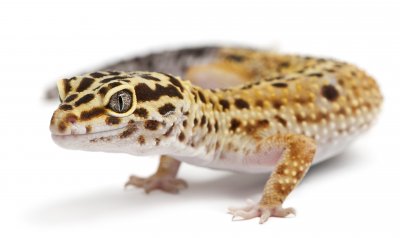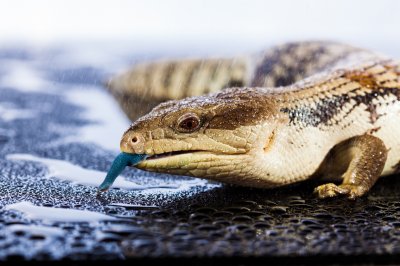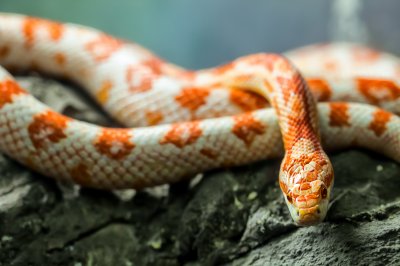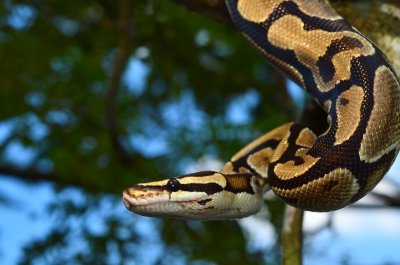So you want a pet. Dogs and cats may be too furry for your tastes. Birds can be delicate and even a bit demanding when it comes to their care. Perhaps an aquarium full of fish? Yes, they are beautiful, but low on the interactive side.
What about a reptile? It could be your perfect pet.
If you've only ever given a reptile as a pet a passing thought, you might be pleasantly surprised to learn they do make excellent "scaly friends." However, being a newbie, you will want to start with the best pet reptile for beginners. But don't worry, we have found those top lizards, snakes, and a turtle, too!
Why Do Reptiles Make Good Pets?
Not convinced a reptile is the best pet for you? Check out the reasons why reptile-lovers are singing their praises.
1. Minimum Mess - All reptiles live in either a vivarium or a tank, so if you keep up on the regular cleanings, they won't even smell.
2. No Allergens - Furry and feathered animals can carry dirt, dust mites, and dander - a big ACHOO for allergy sufferers. However, our scaly friends don't.
3. Easy Feeding - Forget about rushing home at a specific time to feed your reptile, some species only eat a meal a few times a month. This fun fact is because the metabolism of a cold-blooded critter is much lower than their warm-blooded counterparts, so they burn less energy - less energy=less food.
4. Long Lifespan -Every pet parent has probably had to make that difficult decision to "say goodbye" to a beloved furry pal (it can be devastating). Reptiles, on the other hand, can live exceptionally long lives.
5. Alone is Okay - Most reptiles don't mind being alone, so if you like to go away for the weekend, the right reptile will be just fine. Plus, you won't have to worry about them making noise and disturbing your neighbors - great for apartment or condo dwellers!
6. No Walks? No Grooming? No Problem! - If you lack the time or the ambition to walk, groom, or train an animal, reptiles are a perfect choice. But that doesn't mean they won't want to have interaction with you. Reptiles can recognize their pet parent, and some will even be eager to see their best human friend.
Best Reptiles for Beginners
Have we convinced you that a reptile is an excellent pet? Check out the best reptiles for beginners - one of these may be your next BSF (best scaly friend).
Bearded Dragons - Also Known as 'Beardies'

Bearded dragons are excellent for beginners due to their ease-of-maintenance. They will require a spacious tank (at least 40 gallons), which will need to be cleaned entirely about once-a-month. Feeding is a cinch, simply provide him with crickets, mealworms, fresh veggies, and fruit daily.
The Beardie is a beautiful reptile, with a personality to boot. They don't mind being handled, and with the proper leash, you can take your Beardie outside to explore! Plus, Bearded Dragon breeders are now producing these reptiles in various hues of yellow, orange, and red.
This reptile can grow up to 24 inches long and will live from 10 to 15 years!
Fun Beardie Fact: The Beardie has a habit of moving its front arm in a way that makes it look like its waving 'hello' to you.
Leopard Gecko - Like a Little Dino

These hardy lizards have been a favorite pet for over 30 years. And there are good reasons for it. First, they are adorable and come in a variety of colors and patterns. Second, the Leopard Gecko is a smaller lizard reaching up to 10 inches long. Third, they only need a tank around 10 gallons (two can live nicely in a 20-gallon tank). Fourth, they only eat insects.
Once your Leopard Gecko gets used to being handled, he will need about 15 minutes of crawling around on your fingers, per day.
Fun Leopard Gecko Fact: This reptile species can vocalize and wash its eyeball with its tongue!
Blue-Tongued Skink - The One With the Berry-Blue Tongue!

Aside from the fact that this reptile is great for beginners, it also has a berry-blue tongue! This short and stubby lizard is slow-moving and doesn't like to climb much. It is a relatively easy-going and calm lizard that acclimates well to captivity.
There are several varieties of the Blue-tongued Skink, so their size averages from 4 inches up to 30 inches (so know which species you are getting). They eat both meat and plant matter and can live upwards of 20 years!
Fun Blue-Tongued Skink Fact: This reptile sports a glossy skin, which comes in a variety of colors and patterns - something for everyone!
Corn Snake - Doesn't Eat Corn!

If you think a pet snake may be more your style, then the Corn Snake is an excellent choice. This reptile is relatively easy to maintain, docile, and come in a variety of colors and patterns. Corn Snakes need a least a 20-gallon tank to live in and a purely carnivorous diet, meaning you will have to feed this reptile mice or rats.
Even though the Corn Snake is considered small, it can reach average lengths of three to five feet long. Some have even exceeded six feet! The lifespan of this fella is 15 to 20 years.
Fun Corn Snake Fact: When the Corn Snake is frightened, it will shake its tail like a rattlesnake.
Gopher Snake - Bold & Curious!

If you are looking for a more active pet reptile, the Gopher Snake species may be for you. It likes to slither around its enclosure, investing every nook and cranny. But be sure you have a secure lid on your tank, as the Gopher Snake is an escape artist.
Once tamed, this species doesn't mind being handled, but it will want to slither around, so keep those hands moving. It can grow up to lengths of four to five feet, some well over six feet and live upwards of 30 years.
Fun Gopher Snake Fact: When angry, the Gopher Snake will lift and flatten its head out in a triangular shape, shake its tail, and hiss.
Ball Python - Long Life!

When you hear python, you may conjure up images of a massive snake, squeezing the life out of someone. However, according to Reptiles online, the Ball Python isn't like its larger cousins at all. This species is docile (leaning towards shy), friendly, and easy to maintain.
The Ball Python comes in a wide array of colors and patterns, reaching average lengths of two to five feet. This reptile is a carnivore, so you will have to feed it rodents. Its lifespan is approximately 30 years; the record-holder reaching over 40 years!
Fun Ball Python Fact: Ancient royalty once wore the python as "jewelry" earning it the nickname, "royal python."
Red-Eared Slider Turtle - Active & Enjoys Swimming!

The Red-Eared Slider has been winning the hearts of kids and adults alike. The slash of red on each "ear" makes it a sporty pet, but know that they don't care to be handled. This species eats both meat (insects) and plant matter daily.
Keep in mind that the cute little turtle you see at the store or breeders can and will grow up to 12 inches! This reptile will need a spacious tank with an area to bask out of the water and a proper filtration system to help keep the mess to a minimum.
Fun Red-Eared Slider Fact: The average lifespan of the Red-Eared Slider is 20 years. But some have even lived to 30, 40, and 50 years of age!
The Best Reptiles for Beginners - Are You Up For It?
Like any pet, reptiles will need specific care for it to enjoy a long healthy life. Before you embark on reptile keeping, do your research. Not all reptiles may be suitable for your home or lifestyle.
Once you have chosen which reptile is best suited for you, be sure to purchase it from a reputable breeder. Wild-caught reptiles will not make good pets as they tend to be stressed and frightened, which leads to a breakdown in their health. Check the credentials of any prospective breeder to ensure they have the best interest of the pet.